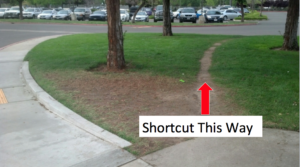Learning Outcomes
- Factor special products

Some people find it helpful to know when they can take a shortcut to avoid doing extra work. There are some polynomials that will always factor a certain way, and for those, we offer a shortcut. Most people find it helpful to memorize the factored form of a perfect square trinomial or a difference of squares. The most important skill you will use in this section will be recognizing when you can use the shortcuts.
Factoring a Perfect Square Trinomial
A perfect square trinomial is a trinomial that can be written as the square of a binomial. Recall that when a binomial is squared, the result is the square of the first term added to twice the product of the two terms and the square of the last term.
A General Note: Perfect Square Trinomials
A perfect square trinomial can be written as the square of a binomial:
In the following example, we will show you how to define a and b so you can use the shortcut.
Example
Factor [latex]25{x}^{2}+20x+4[/latex].
In the next example, we will show that we can use [latex]1 = 1^2[/latex] to factor a polynomial with a term equal to [latex]1[/latex].
Example
Factor [latex]49{x}^{2}-14x+1[/latex].
In the following video, we provide another short description of what a perfect square trinomial is and show how to factor them using a formula.
We can summarize our process in the following way:
How To: Given a perfect square trinomial, factor it into the square of a binomial
- Confirm that the first and last term are perfect squares.
- Confirm that the middle term is twice the product of [latex]ab[/latex].
- Write the factored form as [latex]{\left(a+b\right)}^{2}[/latex] or [latex]{\left(a-b\right)}^{2}[/latex].
Factoring a Difference of Squares
A difference of squares is a perfect square subtracted from a perfect square. Recall that a difference of squares can be rewritten as factors containing the same terms but opposite signs because the middle terms cancel each other out when the two factors are multiplied.
We can use this equation to factor any differences of squares.
A General Note: Differences of Squares
A difference of squares can be rewritten as two factors containing the same terms but opposite signs.
Example
Factor [latex]9{x}^{2}-25[/latex].
The most helpful thing for recognizing a difference of squares that can be factored with the shortcut is knowing which numbers are perfect squares, as you will see in the next example.
Example
Factor [latex]81{y}^{2}-144[/latex].
In the following video, we show another example of how to use the formula for factoring a difference of squares.
We can summarize the process for factoring a difference of squares with the shortcut this way:
How To: Given a difference of squares, factor it into binomials
- Confirm that the first and last term are perfect squares.
- Write the factored form as [latex]\left(a+b\right)\left(a-b\right)[/latex].
Think About It
Is there a formula to factor the sum of squares, [latex]a^2+b^2[/latex], into a product of two binomials?
Write down some ideas for how you would answer this in the box below before you look at the answer.
Candela Citations
- Screenshot: Method to the Madness. Provided by: Lumen Learning. License: CC BY: Attribution
- Image: Shortcut This Way. Provided by: Lumen Learning. License: CC BY: Attribution
- Revision and Adaptation. Provided by: Lumen Learning. License: CC BY: Attribution
- Factor Perfect Square Trinomials Using a Formula. Authored by: James Sousa (Mathispower4u.com) for Lumen Learning. Located at: https://youtu.be/UMCVGDTxxTI. License: CC BY: Attribution
- Ex: Factor a Difference of Squares. Authored by: James Sousa (Mathispower4u.com). Located at: https://youtu.be/Li9IBp5HrFA. License: CC BY: Attribution
- Unit 12: Factoring, from Developmental Math: An Open Program. Provided by: Monterey Institute of Technology and Education. Located at: http://nrocnetwork.org/dm-opentext. License: CC BY: Attribution
